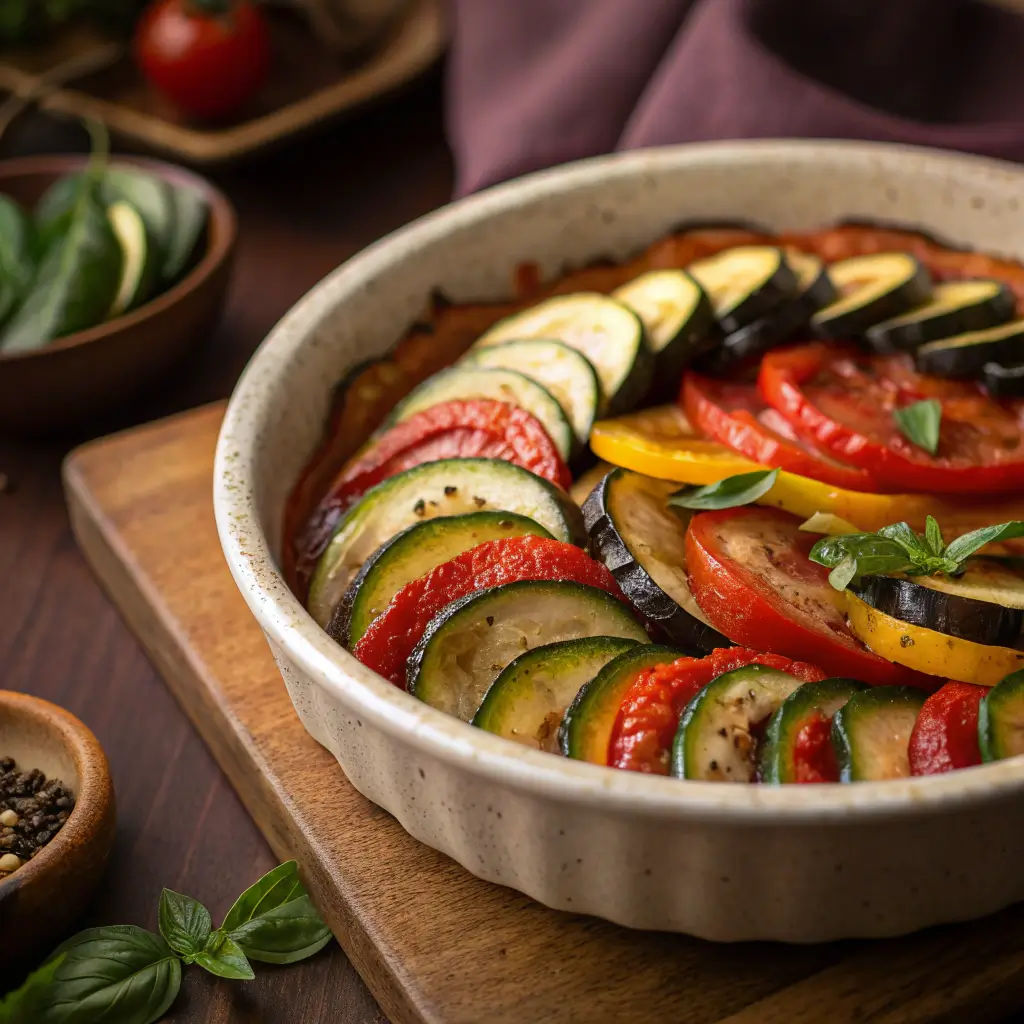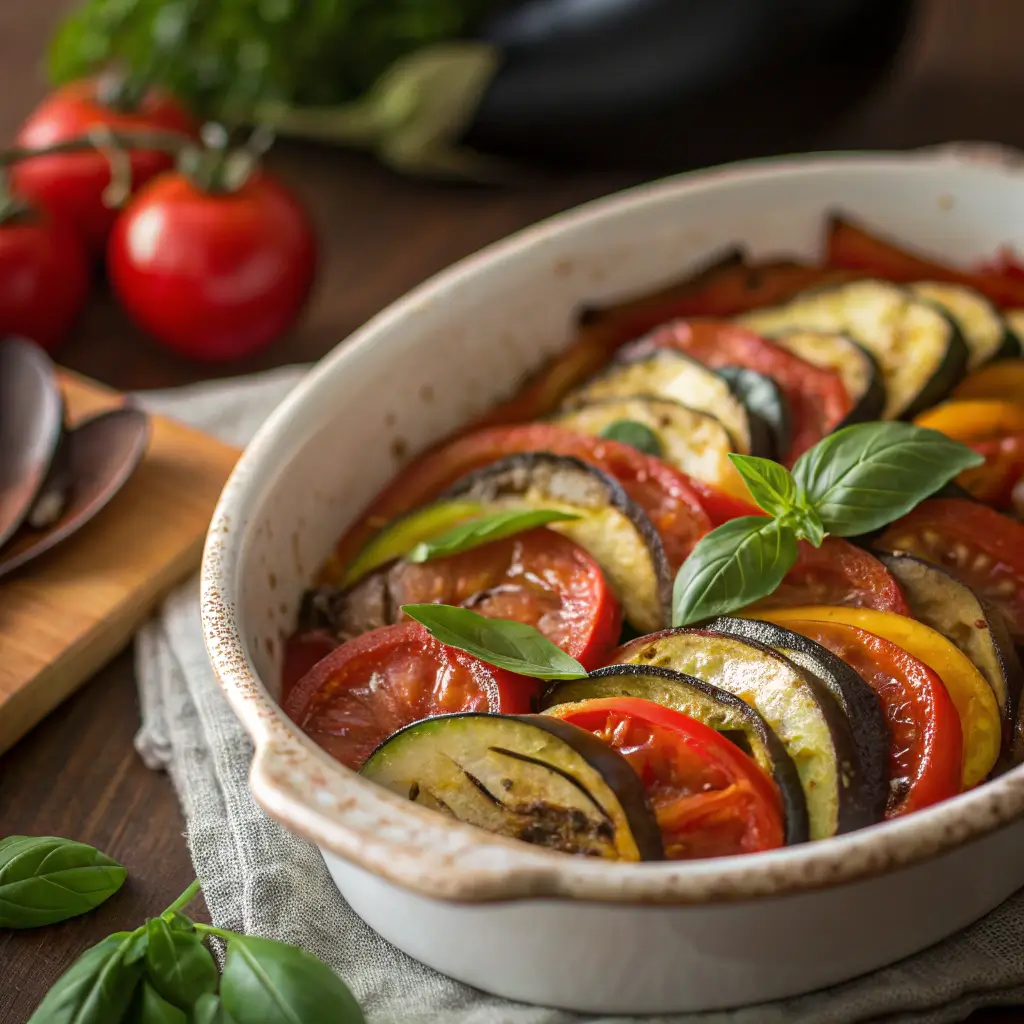Ratatouille with Fresh Spring Vegetables: A Vibrant, Healthy Classic
Introduction
Few dishes capture the essence of fresh seasonal produce quite like ratatouille. Originating from the sun-soaked fields of Provence in southern France, this rustic vegetable medley celebrates simplicity, flavor, and the beauty of fresh ingredients. Traditionally made with summer vegetables like eggplant, zucchini, peppers, and tomatoes, ratatouille is incredibly versatile. By embracing spring vegetables, you can adapt this beloved dish into something that’s lighter, greener, and perfectly suited for the season.
This Ratatouille with Fresh Spring Vegetables swaps out some of the heavier vegetables for tender spring produce like asparagus, peas, young zucchini, carrots, and fresh herbs. The result is a colorful dish that’s bursting with flavor, nutrition, and a touch of elegance. Whether served as a side dish, a vegetarian main course, or a topping for grains and pasta, this ratatouille is a celebration of spring in every bite.

Why You’ll Love This Recipe
- Seasonal twist – Features fresh spring vegetables instead of heavier summer produce.
- Healthy & light – Packed with fiber, vitamins, and antioxidants.
- Versatile – Serve as a side, main dish, or accompaniment to meats and grains.
- Make-ahead friendly – Flavors deepen as it rests, making it even better the next day.
- Beautiful presentation – A colorful dish that brightens up any table.
Ingredients & Equipment
Ingredients (Serves 4–6)
For the Ratatouille:
- 1 medium onion, finely diced
- 1 medium zucchini (or baby zucchini), sliced into half-moons
- 2 tablespoons olive oil
- 1 medium carrot, thinly sliced
- 1 small fennel bulb, thinly sliced (optional, for depth)
- Salt and freshly ground black pepper, to taste
- 1 red bell pepper, diced
- 2 cloves garlic, minced
- 1 cup asparagus, cut into 2-inch pieces
- 1 cup cherry tomatoes, halved
- 1/2 cup fresh peas (or frozen if not available)
- 1 teaspoon fresh thyme leaves (or 1/2 teaspoon dried)
- 1 teaspoon fresh oregano leaves (or 1/2 teaspoon dried)
- 1/2 teaspoon chili flakes (optional, for heat)
- 1 tablespoon tomato paste
For Garnish:
- 2 tablespoons fresh basil, chopped
- 1 tablespoon fresh parsley, chopped
- Grated Parmesan or crumbled feta (optional, for serving)
Equipment
- Large skillet or Dutch oven
- Wooden spoon or spatula
- Sharp knife and cutting board
Step-by-Step Instructions
Step 1: Prep the Vegetables
Wash and trim all vegetables. Slice zucchini and carrots into thin, uniform pieces to ensure even cooking. Cut asparagus into short sections, halve the cherry tomatoes, and finely dice onion and garlic.
Step 2: Sauté Aromatics
Heat olive oil in a large skillet or Dutch oven over medium heat. Add onion and cook until softened and translucent, about 5 minutes. Stir in garlic and cook for 1 more minute, being careful not to burn.
Step 3: Add Base Vegetables
Add zucchini, carrots, and fennel (if using). Cook for 5–7 minutes, stirring occasionally, until they begin to soften.
Step 4: Layer in Spring Vegetables
Add bell pepper, asparagus, and peas. Stir gently, cooking for another 5 minutes to allow the vegetables to become tender yet still vibrant.
Step 5: Build Flavor with Tomatoes & Herbs
Stir in tomato paste, cherry tomatoes, thyme, oregano, chili flakes, salt, and pepper. Reduce heat to low, cover, and simmer for 10–15 minutes. The vegetables should be tender but not mushy, with a rich, lightly saucy base.
Step 6: Finish & Garnish
Remove from heat and stir in fresh basil and parsley. Adjust seasoning if needed. Serve warm, garnished with cheese if desired.
Tips for Perfect Ratatouille
- Don’t overcook: Keep vegetables slightly firm for a fresher texture.
- Use high-quality olive oil: Since the recipe is simple, the oil makes a difference.
- Balance flavors: Add a splash of lemon juice for brightness if the dish feels heavy.
- Cook in layers: Adding vegetables in stages ensures each cooks properly.
- Make it ahead: Ratatouille tastes even better after resting overnight.
Flavor Variations
- Classic Style: Stick to zucchini, eggplant, peppers, and tomatoes for a more traditional version.
- Herb-Forward: Add extra dill, mint, or tarragon for a spring twist.
- Spicy Mediterranean: Stir in a teaspoon of harissa paste for heat and complexity.
- Cheesy Bake: Top with mozzarella or goat cheese and bake until bubbly.
- Grain Bowl: Serve over quinoa, farro, or couscous for a complete meal.
Nutritional Benefits
This spring ratatouille is not just flavorful—it’s also incredibly healthy:
- Zucchini & carrots: High in fiber, vitamin A, and antioxidants.
- Asparagus & peas: Provide plant-based protein, vitamins C and K, and folate.
- Tomatoes: Rich in lycopene, a powerful antioxidant.
- Fresh herbs: Packed with anti-inflammatory compounds and natural flavor.
Low in calories and high in nutrients, this dish is a fantastic way to embrace seasonal eating.

Serving Suggestions
- As a side: Pair with grilled fish, roast chicken, or seared steak.
- Over grains: Serve atop rice, quinoa, or couscous for a vegetarian main dish.
- With bread: Sop up the juices with crusty French bread or focaccia.
- On pasta: Toss with spaghetti or penne for a simple vegetarian dinner.
- As a topping: Use it over baked potatoes, polenta, or even pizza.
Storage & Make-Ahead Tips
- Refrigeration: Store in an airtight container for up to 4 days.
- Freezing: Freeze for up to 2 months. Thaw in the refrigerator before reheating.
- Reheating: Warm gently on the stovetop over low heat or in the microwave.
- Meal prep: Make a big batch and portion for easy lunches and dinners.
Frequently Asked Questions
Q: Can I make ratatouille without tomato paste?
Yes. Simply use extra cherry tomatoes for a fresher, lighter base.
Q: Can I roast the vegetables instead?
Absolutely. Roasting enhances caramelization. Toss veggies in olive oil, roast at 400°F (200°C) for 20–25 minutes, then combine with herbs and tomatoes.
Q: Is ratatouille vegan?
Yes, this recipe is naturally vegan. Adding cheese is optional.
Q: Can I use frozen vegetables?
Fresh is best, but frozen peas or asparagus tips can be used in a pinch.
Why This Recipe Works
This Spring Ratatouille honors the classic French dish while adapting it to seasonal produce. By layering the cooking process, you allow each vegetable to shine while creating a cohesive, flavorful medley. The balance of fresh herbs, tender vegetables, and light tomato base makes it versatile and nourishing. It’s rustic yet elegant—ideal for everything from casual dinners to festive occasions.
Conclusion
Ratatouille with Fresh Spring Vegetables is proof that simple, wholesome ingredients can create a dish that feels both comforting and refined. With its vibrant colors, garden-fresh herbs, and tender vegetables, it’s a versatile recipe you’ll return to all season long.
Serve it as a light vegetarian main, a side for roasted meats, or spooned over grains or pasta. However you enjoy it, this dish brings a taste of Provence into your kitchen while celebrating the very best of spring’s bounty.
